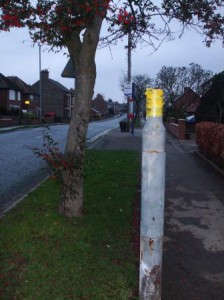As previously reported, the Council is taking £1 million from the road and footpath resurfacing budget to pay for the replacement of the lighting columns that were removed last year. The decision to fell nearly 600 lampposts, without making budget provision for the replacement, has been heavily criticised by residents.
Now it seems that a replacement programme will get underway in April although it is unclear whether the procedural difficulties, which often lead to a big delay in getting power reconnected, have been overcome.
For example, new lampposts were installed in part of Front Street 2 months ago but they are still not working.
The Council report talks of “testing and replacing” a proportion of concrete lampposts which are a feature of many residential estates. Thus it appears that the Council has learned its lesson and is returning to a phased programme of “test & modernise” which should mean that we are unlikely to see massive gaps in the lighting network appearing again.
In a media release, the Council claims that the replacement programme is the biggest since “Victorian times”, conveniently forgetting that the conversion of lighting columns from gas to electricity in the 1930’s a was a much bigger programme (although the major cost then was in cabling works as many of the gas columns were simply modernised to take the new power source)

The “spin” continues with a claim that “in order to preserve York’s unique character the Reinvigorate (sic) board will meet shortly to discuss and agree the best approach for the types and styles of streetlights to be used in the city centre and the other 34 conservation areas across the city. The lights in conservation area locations will be replaced within the scheduled time and are estimated to start in June or July”.
Given that the lampposts in the Acomb Front Street Conservation Area have already been installed, this may just be a piece of window dressing, although QUANGOs like these are notoriously insensitive to the cost pressures faced by taxpayers.
The Council should detail the costs of the different types of lamppost available and take into account the views of affected residents and businesses.

